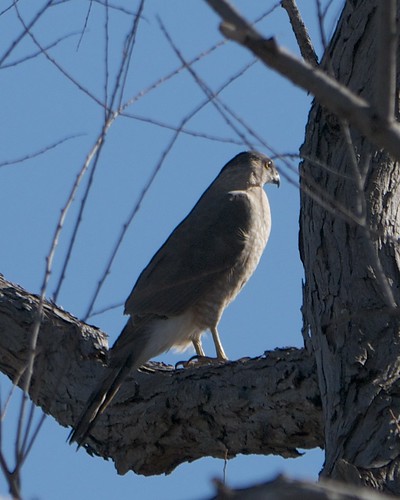About 15 folks met at the Lake Creek Trail parking lot at the end of Braes Valley this morning for the monthly group bird walk. It was cold and clear with a brisk wind, and the birds were quite active. An early highlight was a Hermit Thrush that didn't seem to mind the group and came out into the open quite close to us. Everyone got great looks and it was a good opportunity to learn the field marks of this winter resident bird that often stays hidden in the low dense underbrush. Here's a photo I got:
A little further down the trail we saw lots of Yellow-rumped Warblers, an Eastern Phoebe, American and Lesser Goldfinches, and an Orange-crowned Warbler.
A Brown Creeper made a brief appearance and a few of us got to see this cryptic winter resident bird. We also ran into a mixed group of sparrows that included Lincoln's, White-throated, Field, and Spotted Towhees. Everyone got good looks at the Field Sparrows but the others were more difficult to observe. From the woods south of the trail we heard a Cooper's Hawk vocalizing. Some of us saw a large nest nearby and I wonder if this species will breed here this summer.
At the footbridge we got brief distant looks at Song, Lincoln's, and Swamp Sparrows. In the creek bed downstream we saw an American Pipit, Killdeer, and three Greater Yellowlegs. Greater Yellowlegs are a winter resident shorebird that used to be pretty common on Lake Creek. They got harder to find when the Parmer Village development started, but just this last winter they seem to be coming back and using the creek more often.
On our way back we walked through the woods and saw an American Robin. We also saw probably the same Cooper's Hawk that we heard vocalizing earlier. Here's a poorly exposed photo I got:
When we got back onto the trail we saw a Hermit Thrush again, and I got this photo showing the field mark that distinguishes it from other thrushes. See how overall the bird is grey-brown, maybe with a little olive mixed in. But the tail and rump are a reddish brown. This reddish brown is distinctive to Hermit Thrush.
We saw or heard 37 species all together. Here's our complete list.




No comments:
Post a Comment